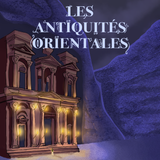Éclectique et botanique • Culture Gazon
00:00
00:59

DESCRIPTION DE L’ÉPISODE
Notre voyage dans les Antiquités orientales fait aujourd’hui escale au bord du Golfe Persique, tout au sud de l’Irak, dans une terre riche, fertile, encadrée par le Tigre et l’Euphrate, fière contrée où fleurissait il y’a maintenant 5000 ans la civilisation des Sumériens. Dans cet épisode nous irons explorer leur culture au travers de l’écriture, et de tout ce qui peut lui être rattaché. Comment apprend-on à lire ou écrire, pourquoi écrit-on, qui en a l’opportunité et quels pouvoirs cela implique-t-il sur les hommes et le monde, ou plutôt : quelle symbolique l’écriture porte-t-elle chez les Sumériens ?
PRODUCTION
Radio Campus Paris, 93.9 F.M.
ECRITURE ET NARRATION
Noa Peringer
MUSIQUES
Anthemousa on the Ancient Lyre – Seikilo
Arab Marshes – Geoff Knorr (Sid Meier’s Civilization V)
Babylonian Banquet – Michael Levy
Générique des Antiquités Orientales – Noa Peringer (Avec la voix de Sébastien Petit)
Hizuo – Mii Theme Dub
Iasis, the Healing Process (in Dorian Mode) – Seikilo
Jungle World Funky Suspense – Christophe Héral (Rayman Origins)
Mysterious Swamps – Christophe Héral (Rayman Legends)
Nebuchadnezzar OST
Persian Flower - Hicham Chahidi
Spark (Live) – Seikilo
The Hourglass – Ben Crosland
The Risen Fleet – Darren Korb (Hades II)
The Way – Tunde Jegede
L’entièreté des musiques de fond et d’ambiance de cet épisode n’est utilisée que pour accompagner le récit, et ne reconstitue en aucun cas la musique antique.
SOURCES
BIBLIOGRAPHIE
· BOTTERO J., L’Ecriture, la Raison et les Dieux, Paris : 1987.
· CHARPIN D., Lire et Écrire à Babylone, Vendômes :Presses Universitaires de France, 2008.
· CRISOSTOMO C., « Sumerian Divination », dans CHRISOSTOMO C, ESCOBAR E., TANAKA T. et VELDHUIS N. (éds.), « The Scaffolding of Our Thoughts », Essays on Assyriology and the History of Science in Honor of Francesca Rochberg, Ancient Magic and Divination 13, Leiden-Boston : Brill, 2018.
· GEORGE A., « In Search of the É.DUB.BA.A : the Ancient Mesopotamian School in Literature and Reality » dans SEFATI Y. et al. (ed.), An Experienced Scribe Who Neglects Nothing: Ancient Near Eastern Studies in Honor of Jacob Klein, Bethesda : CDL Press, 2005.
· GLASSNER J.-J., Écrire à Sumer, Paris : Editions du Seuil, 2000.
· MANDER P., « Designs on the Fara, Abū-Ṣalābīkh and Ebla Tablets » Annali Dell’Istituto Orientale Di Napoli 55, 1995 p. 18–29.
· POLLOCK S., « From Clay to Stone : Material Practices and Writing in Third Millenium Mesopotamia », dans BALKE T. et TSOUPAROPOULOU C. (eds.), Materiality of Writing in Early Mesopotamia, Materiale Textkulturen, Berlin-Boston : De Gruyter, 2016.
· VANSTIPHOUT H., Epics of Sumerian Kings. The Matter of Aratta, Writings from the Ancient World 20, Atlanta : Society of Biblical Literature, 2003.
· VELDHUIS N., « How Did They Learn Cuneiform ? Tribute/Word List C as an Elementary Exercise » dans : MICHALOWSKI P. et VELDHUIS N., Approaches to Sumerian Literature. Studies in Honour of Stip (H. J. L. Vanstiphout), Leiden – Boston : Brill, 2006.
REMERCIEMENTS



